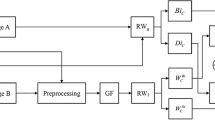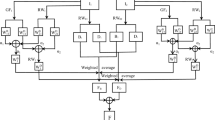Abstract
The purpose of multi-focus image fusion is to acquire an image where all the objects are focused by fusing the source images which have different focus points. A novel multi-focus image fusion method is proposed in this paper, which is based on PCNN and random walks. PCNN is consistent with people’s visual perception. And the random walks model has been proven to have enormous potential to fuse image in recent years. The proposed method first employs PCNN to measure the sharpness of source images. Then, an original fusion map is constructed. Next, the method of random walks is employed to improve the accuracy of the fused regions detection. Finally, the fused image is generated according to the probability computed by random walks. The experiments demonstrate that our method outperforms many existing methods of multi-focus image fusion in visual perception and objective criteria. To assess the performance of our method in practical application, some examples are given at the end of paper.














Similar content being viewed by others
References
Hua K-L, Wang H-C, Rusdi AH, Jiang S-Y (2014) A novel multi-focus image fusion algorithm based on random walks. J Vis Commun Image Represent 25(5):951–962
Moonon A-U, Hu J (2015) Multi-focus image fusion based on NSCT and NSST. Sens Imaging 16(1):1–16
Wang Z, Ma Y, Cheng F, Yang L (2010) Review of pulse-coupled neural networks. Image Vis Comput 28(1):5–13
Liu Z, Yin H, Chai Y, Yang SX (2014) A novel approach for multimodal medical image fusion. Expert Syst Appl 41(16):7425–7435
Zhao C, Shao G, Ma L, Zhang X (2014) Image fusion algorithm based on redundant-lifting NSWMDA and adaptive PCNN. Opt Int J Light Electron Opt 125(20):6247–6255
Geng P, Wang Z, Zhang Z, Xiao Z (2012) Image fusion by pulse couple neural network with shearlet. Opt Eng 51(6):067005
Xiang T, Yan L, Gao R (2015) A fusion algorithm for infrared and visible images based on adaptive dual-channel unit-linking PCNN in NSCT domain. Infrared Phys Technol 69:53–61
Yanchun Y, Yangping W (2014) Medical image fusion method based on lifting wavelet transform and dual-channel PCNN, pp 1179–1182
Wang Z, Ma Y, Gu J (2010) Multi-focus image fusion using PCNN. Pattern Recognit 43(6):2003–2016
Wang Z, Ma Y (2008) Medical image fusion using m-PCNN. Inf Fusion 9(2):176–185
Li M, Cai W, Tan Z (2006) A region-based multi-sensor image fusion scheme using pulse-coupled neural network. Pattern Recognit Lett 27(16):1948–1956
Huang W, Jing Z (2007) Multi-focus image fusion using pulse coupled neural network. Pattern Recognit Lett 28(9):1123–1132
Zhang Y, Chen L, Zhao Z, Jia J, Liu J (2014) Multi-focus image fusion based on robust principal component analysis and pulse-coupled neural network. Opt Int J Light Electron Opt 125(17):5002–5006
Pearson K, Pearson K The problem of the random walk. Nature 268(1481):2113–2122
Rota Bulò S, Rabbi M, Pelillo M (2011) Content-based image retrieval with relevance feedback using random walks. Pattern Recognit 44(9):2109–2122
Smolka B, Wojciechowski KW (2001) Random walk approach to image enhancement. Sig Process 81(3):465–482
Sun X, Rosin PL, Martin RR, Langbein FC (2008) Random walks for feature-preserving mesh denoising. Comput Aided Geom Des 25(7):437–456
Grady L (2006) Random walks for image segmentation. IEEE Trans Pattern Anal Mach Intell 28(11):1768–1783
Ram S, Rodriguez JJ (2013) Random walker watersheds: a new image segmentation approach. In: ICASSP, IEEE international conference acoustics, speech and signal processing—Proceedings, pp 1473–1477
Grady L, Funka-Lea G Multi-label image segmentation for medical applications based on graph-theoretic electrical potentials, Lecture Notes Computer Science, pp 230–245
Shen R, Cheng I, Shi J, Basu A, Generalized random walks for fusion of multi-exposure images. IEEE Trans Image Process 20(12):3634–3646
Bejinariu SI, Rotaru F, Nita CD, Luca R (2013) Parallel approach for multifocus image fusion. International symposium on signals circuits and systems, ISSCS 2013, Lasi, Romania, pp 1–4
Qu X-B, Yan J-W, Xiao H-Z, Zhu Z-Q (2008) Image fusion algorithm based on spatial frequency-motivated pulse coupled neural networks in nonsubsampled contourlet transform domain. Acta Autom Sin 34(12):1508–1514
Liu Y, Liu S, Wang Z (2014) A general framework for image fusion based on multi-scale transform and sparse representation
Qu X, the code of NSCT-SF-PCNN. https://sites.google.com/site/xiaoboxmu/publication. Accessed 01 Jan 2015
Liu Y, The code of multi-scale transform and sparse representation. http://home.ustc.edu.cn/~liuyu1/
Rockinger O, Image fusion toolbox for Matlab, Technical report. http://www.metapix.de/toolbox.htm
Liu Z, Blasch E, Xue Z, Zhao J, Laganière R, Wu W (2011) Objective assessment of multiresolution image fusion algorithms for context enhancement in night vision: a comparative study. IEEE Trans Pattern Anal Mach Intell 34(1):94–109
Hossny M, Nahavandi S, Creighton D (2008) Comments on ‘Information measure for performance of image fusion’. Electron Lett 44(18):1066
Wang Q, Shen Y, Jin J (2008) Performance evaluation of image fusion techniques. In: Stathaki TBT-IF (ed) Image fusion algorithms and applications. Academic Press, Oxford, pp 469–492
Xydeas CS, Petrović V (2000) Objective image fusion performance measure. Electron Lett 36(4):308
Acknowledgments
This work is jointly supported by China Postdoctoral Science Foundation (Grant No. 2013M532097), National Science Foundation of China (Grant No. 61201421), Special Foundation for Glacier Frozen Earth Talents Training Fund of China (Grant No.J1210003/J0109), The 12th Five-Year Informatization Project of the Chinese Academy of Sciences (Grant No.XXH12503-05-07).
Author information
Authors and Affiliations
Corresponding author
Rights and permissions
About this article
Cite this article
Wang, Z., Wang, S. & Guo, L. Novel multi-focus image fusion based on PCNN and random walks. Neural Comput & Applic 29, 1101–1114 (2018). https://doi.org/10.1007/s00521-016-2633-9
Received:
Accepted:
Published:
Issue Date:
DOI: https://doi.org/10.1007/s00521-016-2633-9




